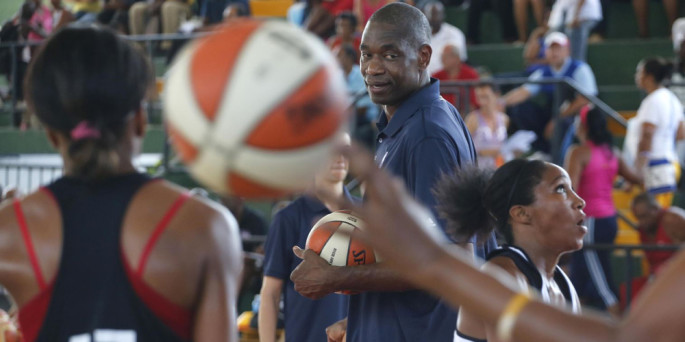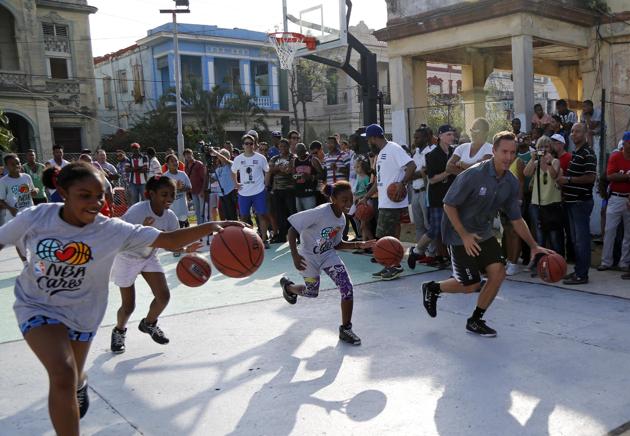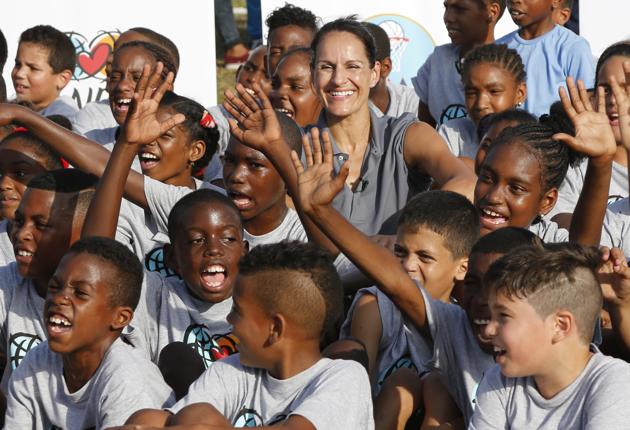
NBA and Cuba: A bridge between two worlds
HAVANA — Since April 23, the National Basketball Association (NBA) has been in Cuba, enough time to turn its presence into constant newspaper headlines.
And no wonder. With its arrival, the NBA has taken a historic step as the first U.S. league to come to Cuba in the past 56 years.
Within the project “Basketball Without Borders,” the clinic that the NBA staged on Cuban soil April 23-26 covered a broad spectrum, because it included training with athletes, courses for coaches, referees and sports medics. All courses were given by recognized figures in U.S. basketball.
On the first day of work, Dikembe Mutombo, the NBA’s Global Ambassador and the man selected this year to enter the Hall of Fame, said that “our trip this week is historic, and we are very happy to have started this bridge. We’re also happy that there are so many young people in Cuba to develop basketball.”
With training camps in almost 220 countries in every continent, the NBA had not been able to access Cuba until this year. But, after the presidential statements of Dec. 17, the world’s top basketball players started pulling strings and took quick advantage of the new context.
Thus, in barely two months, they made the necessary contacts with the International Federation of Amateur Basketball (FIBA) and the Cuban sports authorities, organized an event of broad proportions and landed in Havana. Between the announcement of the visit, on April 13, and the start of the clinic only 10 days elapsed.
The first encounter on Cuban soil took place in March, during the semifinals of the Superior Basketball League, when an advance team led by Kim Bohuny, the NBA’s public relations chief, brought a concrete project for discussion with the INDER and the Cuban Basketball Federation (FCB). Then, the real work began.
And that work led to the arrival in Havana of a de-luxe delegation constituted by the former players Mutombo, Steve Nash and Tich Penicheiro; coaches Quin Snyder and Brad Jones (Utah Jazz), James Borrego (Orlando Magic) and Don Showalter (15-year member of the national teams); as well as Anthony Goenaga (New York Knicks’ trainer), Tommy Sheppard (vice president of the Washington Wizards), and Geraldo Fontana, FIBA referee for the Americas.
If anything is clear to everyone it’s that this clinic deals only with basketball, the future of basketball in Cuba, and finding a way to support the development of young talent in the sport. That’s the premise that has guided the work of the NBA worldwide and the premise espoused by its ambassadors in Havana.
Mutombo left no space for interpretation when he explained that “we members of the NBA and the FIBA are not here as politicians but as players. This is more about a culture of exchange; it’s more about the future of young men and women. This is a sport that goes beyond politics and has no borders. We have done this same job in many other countries and today we’re very happy to be here.”
That statement was echoed by Ruperto Herrera, bronze medalist in the 1976 Olympics and president of the FCB, who totally supports that vision and sees in this first NBA visit to Cuba a magnificent possibility for the advancement of this sports discipline.
For his part, Steve Nash — twice MVP and eight times an NBA All-Star — said that “Cuba has always provided phenomenal athletes and the more exposure and clinics of this type they have, the greater will be the development of those athletes. Today they have a fine basketball program, but it’s time that they get a lot more help so they may continue to grow.”
The NBA has done its part and this is a new bridge between two countries that have found in sports a perfect means to establish relations, a new meeting point for two peoples who continue to find similarities between themselves and who bet on narrowing distances outside of politics.
The open road, or, what will the NBA leave behind?
Beyond the media circus, the spectacular dribbling of Steve Nash and Dikembe’s perfect hook shots, the NBA has given Cuban basketball a breath of fresh air, not because all problems might be solved in four days or because a new generation of star players might be developed, but because this experience foretells a new path of cooperation.
To that effect, Alberto García, the FIBA’s regional director for the hemisphere, announced that, from this clinic, two males will be selected for the regional camp based in the Dominican Republic in August or September.
“Playing in those events of ‘Basketball Without Borders’ of which almost a dozen have been held in the past 12 years between FIBA and the NBA are young players who have been selected by NBA scouts in their countries and evidently have a very special talent,” García says.
Basically, it is a stage for promising basketball players to “display themselves to the NBA, which is always looking for talent that it can use later.”
The president of FIBA-Americas also says that “many of those who have excelled in those camps have had opportunities to play and study in U.S. universities, which is a great opportunity for these kids.”
The entire management of basketball in Cuba has declared the arrival of this NBA delegation to be very positive.
“Undoubtedly, it is a unique opportunity for these boys to have a chance to train for four days under NBA coaches and technical personnel, because [our visitors] have always been leaders in basketball technique,” said Ruperto Herrera.
Speaking about the quality of the players, Nash considers that “there’s plenty of talent, but they need a more competitive structure. Some of their players need to go outside the island. It is very difficult to maintain a competitive level, but the talent is here.”
Meanwhile, Mutombo hinted at what the NBA expects when he said that “there’s many players in Cuba, but we’re concentrating on the youngest, who are the future.”
In addition to the four days of intense training, the NBA’s Cuban incursion had an impact on community basketball because the project included work with children, as well as the painting and restoration of the outdoor courts at 23rd and B streets, at Sports City, and the Manuel Fajardo Physical Culture and Sports University.
The NBA has made history with this rapprochement because, beginning now, the mythical basketball league will be a point of reference for those in Cuba who want to seek adventure.
Already engraved in the memory of the participants are the images of Nash and Mutombo, smiling on the court while they correct stances and enjoy a common passion: basketball.




